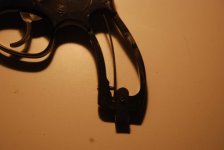.357MagNYC
Member
I took my 586-4 to the range today, and had 4 misfires out of a total of 50 rounds using factory FMJ 38+p ammo (unfortunately I forgot which brand).
After one misfire, I fired the next few rounds, then emptied the cylinder, put the unfired round back in, and it fired on the second try. But the other 3 would not fire in the 586 even after a few tries. (All the other 46 rounds fired as the should, no problem.) So I borrowed a Model 10 from the range. Two of the "dud" rounds fired on the first try, but the third one misfired on the first try before firing on the second.
I checked the strain screw on the 586 and it's tight. Do you guys think this is an ammo problem or a gun problem? I've occasionally had a round misfire here and there with my revolvers before, but it's only been 1-2 a box, and I've always just chalked it up to poor quality control on the ammo.
Thanks!
After one misfire, I fired the next few rounds, then emptied the cylinder, put the unfired round back in, and it fired on the second try. But the other 3 would not fire in the 586 even after a few tries. (All the other 46 rounds fired as the should, no problem.) So I borrowed a Model 10 from the range. Two of the "dud" rounds fired on the first try, but the third one misfired on the first try before firing on the second.
I checked the strain screw on the 586 and it's tight. Do you guys think this is an ammo problem or a gun problem? I've occasionally had a round misfire here and there with my revolvers before, but it's only been 1-2 a box, and I've always just chalked it up to poor quality control on the ammo.
Thanks!


